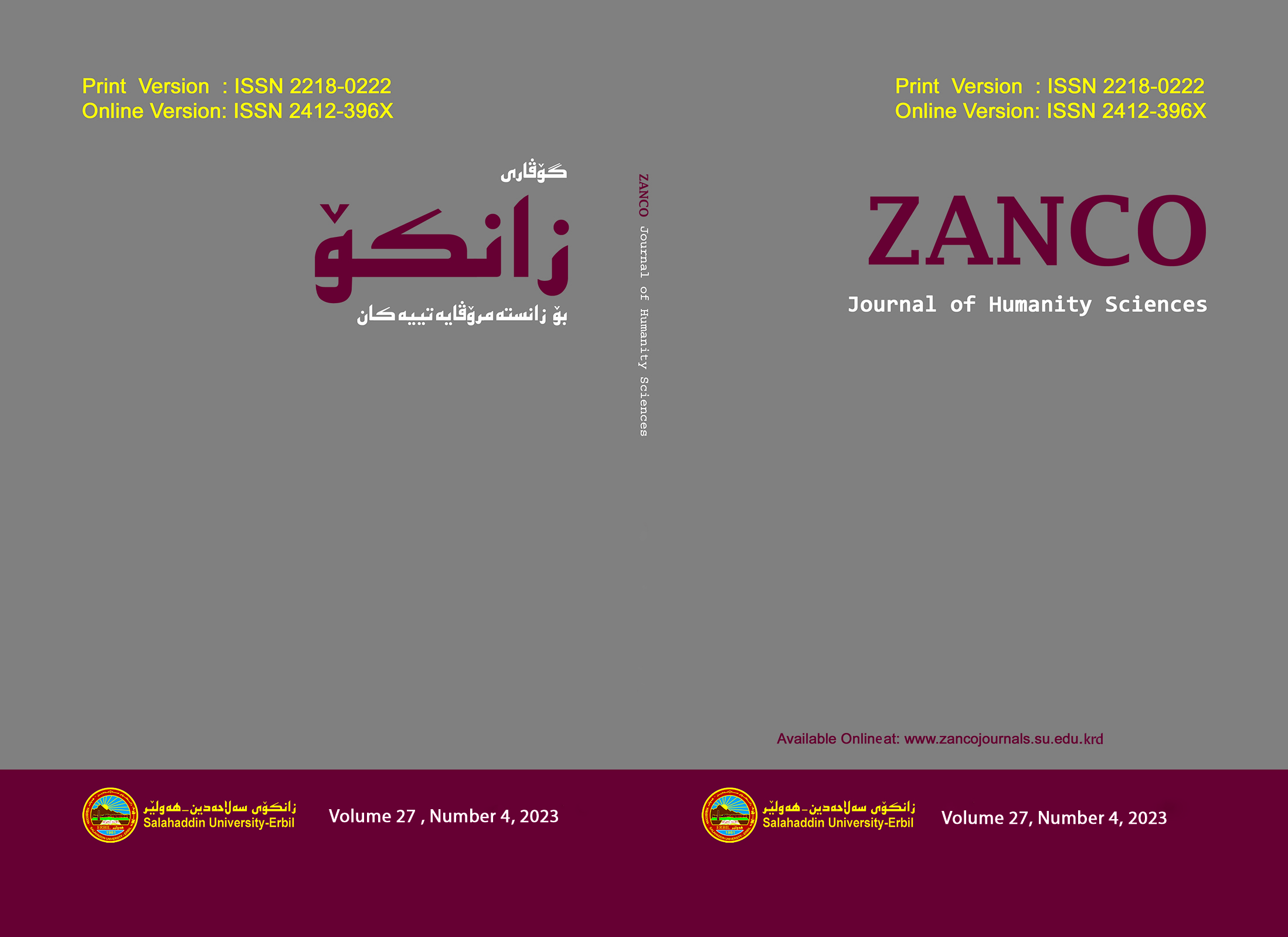Linguistic Analysis of Conceptual Metaphors in English and Kurdish Political Speeches
DOI:
https://doi.org/10.21271/zjhs.27.4.22Keywords:
metaphor, conceptual metaphor, MIP(VU), syntactic analysis, language programmingAbstract
This paper provides a linguistic analysis of conceptual metaphors in English and Kurdish political speeches. Simply put, metaphor is understanding something in terms of another, to find correspondence between two different semantic domains. The data is collected from presidential speeches given between the years 2005 to 2022. In total, there are 16 speeches selected, eight speeches for each language, encompassing 32305 words for English speeches and 17932 words for Kurdish. In the first step, the lexical units were recognized and after that, metaphors are highlighted in the speeches based on Metaphor Identification Procedure (Vrije Universiteit) (MIP(VU)). After identifying linguistic metaphors, distinct characteristics, especially syntactic, of each unit, it appears there can be syntactic patterns for a big number of words when occur in political speeches; some words appear to be always linking verb; metaphoricity of some verbs depends on the transitivity of the verb; some words appear to be always metaphorical in political discourse but not in another register. With these syntactic characteristics designed as codes, it becomes easy to build software through language programming to identify metaphors mechanically.
References
• Alm-Arvius, C. (2003). Figures of Speech. Lund, Sweden: Studentlitteratur.
• Barnden, J. A. (2008). Metaphor and artificial intelligence: Why they matter to each other. In Gibbs Jr, R. W. (Ed.). The Cambridge handbook of metaphor and thought. Cambridge: Cambridge University Press.
• Charteris-Black, J. (2019). Metaphors of Brexit: No cherries on the cake?. Palgrave Macmillan, Cham.
• Connolly, J. (2007). The State of Speech. Rhetoric and Political Thought in Ancient Rome. Princeton, Princeton University Press.
• Divan of Kurdistan Region Presidency, (2014-2018). Mas'd Barzani: Pêşmergeyek le pêgey seroky herêm (Masud Barzani: A Peshmerga at regional president office). Presidency of Kurdistan Region.
• Goatly, A. (2007). Washing the Brain: Metaphor and hidden ideology (Vol. 23). Amsterdam, John Benjamins Publishing.
• Hart, C. (2008). Critical discourse analysis and metaphor: Toward a theoretical framework. Critical Discourse Studies, 5(2), 91-106.
• Holyoak, K. J., & Stamenković, D. (2018). Metaphor comprehension: A critical review of theories and evidence. Psychological Bulletin, 144(6), 641.
• Khadpe, P., Krishna, R., Fei-Fei, L., Hancock, J. T., and Bernstein, M. S. (2020). Conceptual metaphors impact perceptions of human-ai collaboration. Proceedings of the ACM on Human-Computer Interaction, 4(CSCW2), 1-26.
• Kirby, J. T. (1997). Aristotle on metaphor. American Journal of Philology, 118(4), 517-554.
• Kövecses, Z. (2010). Metaphor: A practical introduction. New York, Oxford University Press.
• Kövecses, Z. (2020). Extended Conceptual Metaphor Theory. Cambridge, Cambridge University Press.
• Lakoff, G. (16/10/2013). Cascade Theory: Embodied Cognition and Language from a Neural Perspective, Lecture. Youtube. Available at [https://www.youtube.com/watch?v=XWYaoAoijdQ&list=PLyRLzgGi286_RZ87m34gODwFWC1wQHcU6&index=10]. Retrieved 28/07/2021].
• Lakoff, G. (2014). The all new don't think of an elephant!: Know your values and frame the debate. Vermont, Chelsea Green Publishing.
• Landau, M. (1961). On the use of metaphor in political analysis. Social Research, 331-353.
• Larsson, S., and Heintz, F. (2020). Transparency in artificial intelligence. Internet Policy Review, 9(2).
• Lopez-Gonzalez, H., Guerrero-Solé, F., Estévez, A., and Griffiths, M. (2018). Betting is loving and bettors are predators: A conceptual metaphor approach to online sports betting advertising. Journal of Gambling Studies, 34(3), 709-726.
• Marks, M. P. (2018). Revisiting metaphors in international relations theory. New York: Palgrave Macmillan.
• Musolff, A. (2020). Political metaphor in world Englishes. World Englishes, 39(4), 667-680.
• Pragglejaz Group (2007). MIP: A method for identifying metaphorically used words in discourse. Metaphor and Symbol, 22, 1–40.
• Semino, E., and Masci, M. (1996). Politics is football: Metaphor in the discourse of Silvio Berlusconi in Italy. Discourse & Society, 7(2), 243-269.
• Slosser, J. L. (2019). Components of Legal Concepts: Quality of Law, Evaluative Judgement, and Metaphorical Framing of Article 8 ECHR. European Law Journal, 25(6), 593-607.
• Soto-Andrade, J. (2018). Enactive metaphorising in the learning of mathematics. In Invited lectures from the 13th international congress on mathematical education (pp. 619-637). Springer, Cham.
• Steen, G. J., Dorst, A. G., Herrmann, J. B., Kaal, A. A., Krennmayr, T., and Pasma, T. (2010). A method for linguistic metaphor identification: From MIP to MIPVU. Converging Evidence in Language and Communication Research, (14).
• Tay, D. (2020). Co-constructing ‘crisis’ with metaphor: A quantitative approach to metaphor use in psychotherapy talk. In Huang and Holmgreen. The Language of Crisis (pp. 231-254). John Benjamins.
• Ţenescu, A. (2021). Absinthe in Advertising Discourse. In Parpala E., and Popescu. COMMUNICATING IDENTITIES. LITERATURE AND OTHER FORMS OF VERBAL INTERACTION, 141-147.
• Veale, T., Shutova, E., and Klebanov, B. B. (2016). Metaphor: A computational perspective. Synthesis Lectures on Human Language Technologies, 9(1), 1-160.
• Veit, W., and Ney, M. (2021). Metaphors in arts and science. European Journal for Philosophy of Science, 11(2), 1-24.
• Winkielman, P., Coulson, S., and Niedenthal, P. (2018). Dynamic grounding of emotion concepts. Philosophical Transactions of the Royal Society B: Biological Sciences, 373(1752), 20170127.
• Winter, B., Daguna, J., and Matlock, T. (2018). Metaphor-enriched social cognition and spatial bias in the courtroom. Metaphor and the Social World, 8(1), 81-99.
• Zabotkina, V. (2012). Cognitive Modeling in Linguistics: Conceptual Metaphors. Lecture at ShanghAI Lectures (University of Zurich), 29 November, 2012. Accessed 10/04/2021.
• Zhang, C., & Xu, C. (2018). Argument by multimodal metaphor as strategic maneuvering in TV commercials: A case study. Argumentation, 32(4), 501-517.
• Zhong, C. B., and Leonardelli, G. J. (2008). Cold and lonely: Does social exclusion literally feel cold?. Psychological Science, 19(9), 838-842.
Downloads
Published
How to Cite
Issue
Section
License
Copyright (c) 2023 Rozgar Yousif Omar, Himdad Abdulqahhar Muhammad

This work is licensed under a Creative Commons Attribution-NonCommercial-ShareAlike 4.0 International License.
Except where otherwise noted, content on this site is licenced
under a Creative Commons Attribution License 4.0 (CC BY- 4.0)










